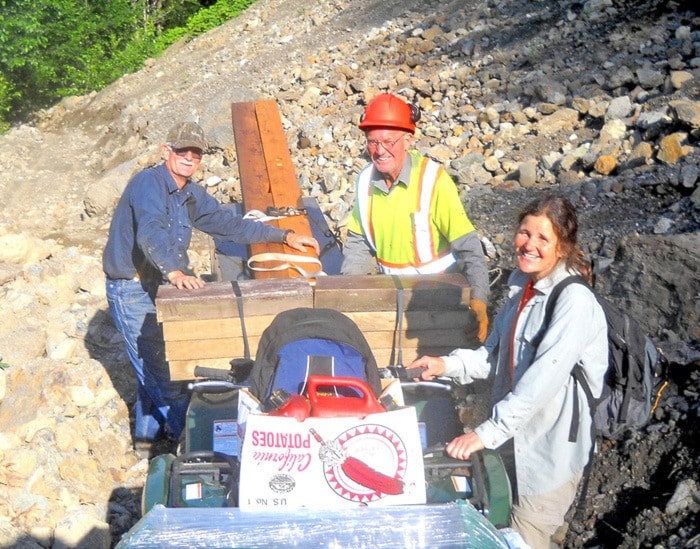The folks at Hope Mountain Centre for Outdoor Learning just can’t have enough trails... so they’ve been busy making big improvements to a historic trail that had fallen into disuse: the Hudson Bay Company’s 1849 Heritage Trail, which begins in the Peers Creek Valley, east of Othello, and leads all the way to Otter Lake at Tulameen.
The whole hike could take the better part of a week, so multiple camping sites are being set up, no more than 10 kilometres apart. The sites include bear proof food caches, toilets, raised tent pads — and running water... if you include the streams running down the hill.
Crews have been busy in the Peers Creek Valley for the last two weeks, says Hope Mountain Centre’s program director, Kelly Pearce.
Wayne Furness used his Kubota excavator to clear a path through the decommissioned logging road that roughly follows the old trail. Ken Hayes assisted by felling trees and watching for rock falls, while Furness cleaned up the rock slide areas, making the path wide enough for the ATVs that were used to haul tools and materials to the campsite near the six kilometre point.
Once the ATVs were done, Pearce says Furness installed pinch points out of large boulders, to block further access by motorized vehicles. The trail is intended for hikers, horses and mountain bikers only.
“Wayne and Ken were funded directly by Recreation Sites and Trails BC,” Pearce adds.
“We also have a crew of two workers, Robbie Sherman from Hope and Trevor O’Farell, who was a Katimavik kid who came back here to live and work in Hope. And we have two crew leaders, who spell each other off or sometimes work together. Kelley Cook is from Princeton and she is a very experienced trail builder. She visited us to encourage us to get working on our end of the trail.
“Justin Brown is our other crew leader. He is an experienced mountaineer, trail builder and local photographer. Those four will be working for six weeks this summer, setting up three campsites and they are paid by the New Pathways to Gold Society,” explains Pearce.
The crew camped overnight while they worked on the six kilometre Manson’s Historic Campsite, which gave them time to discuss the design and make improvements over several days, says Pearce. He adds that the original camp would have been closer to the creek, where there is more level ground for the men and hundreds of horses that would rest there overnight.
This site would have been the first camp of the horse brigade out of Fort Hope, as Pearce says they would travel about 20 miles per day.
Henry Peers, a surveyor for the Hudson’s Bay Company was charged with building a fort at Hope in 1848 — and with finding a new route for the brigade, which would be coming from Fort Kamloops in 1949. He had a crew of 10 to help. The first HBC trail, which came over the mountains near Spuzzum, had been brutal on the men and horses, the two times it was used. A better route was needed.
Today’s trail fast-tracks the main part of the return brigade’s day. They would have begun in Hope and come up the Coquihalla Canyon, climbing out of the gorge to avoid the area where the tunnels are now. They would then travel along the Coquihalla to Peers Creek.
The modern trail head begins at about the 330-metre elevation and the campsite sits at about 950 metres... so it’s a fairly gradual rise over the six kilometres. A cyclist with low gearing and tough, knobby tires should be able to make most of the steeper parts. Even if you pushed the bike for part of the way, it would be so much easier to ride back to your car after a long day-hike.
It’s a long way to walk back out — if you decide to hike up to Manson’s Ridge, where you can get a great view (on a clear day) of the Peers Creek Valley and the Sowaqua Valley to the east. You’ll gain about 500 metres of elevation on the two-kilometre bonus hike — a steeper grade than even the first two kilometres of the Tikwalus Trail — so if you’re just going for the view, it’s important to monitor the cloud cover. On Monday, there was still snow at the ridge and only a partial view to the east.
What an incredible trip it would have been for the unshod brigade horses, each laden with 180 pounds of furs, tools, gold or mail, says Pearce. Still, it didn’t involve a swim across the Fraser and the foraging was much better in the Tulameen Plateau, he adds.
Today, mountain bikers would park their rides at the campsite but hardy horse riders can still make the grade, says Pearce.
“It spooks a lot of riders — but experienced back-country riders love to do that, walking in the footsteps of the old brigade.”
The reborn trail is steadily taking shape and Pearce says the goal is to complete it in 2012, then promote it heavily next year.
In addition to the paid crews, Pearce says dozens of volunteers have already helped — and continue to help — on this and other trails in the region.
For details, visit hopemountain.org.
